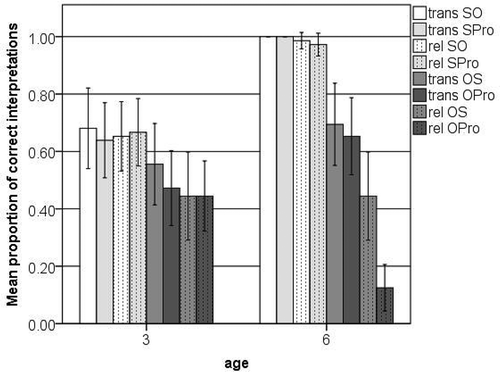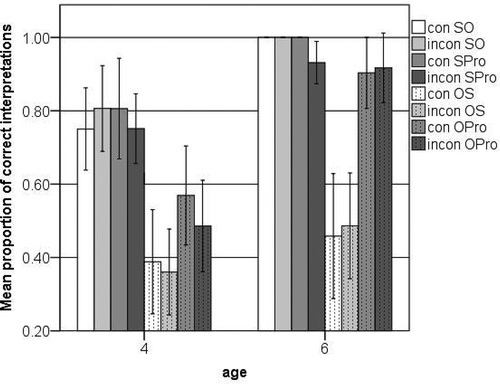Figures & data
Table 1. Use of demonstrative pronouns in German (Leo corpus).
Table 2. Conditions and example sentences for simple transitives and transitive RCs with no case marking on lexical NPs or demonstrative pronouns.
Figure 1. Subject-first interpretations of simple transitives (trans) and transitive RCs (rel) with no case marking on lexical NPs (NN) or demonstrative pronouns (NPro) (Experiment 1).

Table 3. GLMM main effects Experiment 1. Subject-first interpretations of simple transitives and transitive RCs with no case marking on lexical NPs or demonstrative pronouns.Footnote5
Table 4. GLMM main effects 3-year-olds Experiment 1. Subject-first interpretations of simple transitives and transitive RCs with no case marking on lexical NPs or demonstrative pronouns.Footnote6
Table 5. Conditions and example sentences for simple transitives and transitive relative clauses with case marking on lexical NPs and demonstrative pronouns.
Figure 2. Correct interpretations of simple transitives (trans) and transitive relative clauses (rel) with case marking on lexical NPs (SO, OS) and demonstrative pronouns (SPro, OPro) (Experiment 2).

Table 6. GLMM main effects and 2-way interactions Experiment 2. Correct interpretation of simple transitives and transitive relative clauses with case marking on lexical NPs and demonstrative pronouns.
Table 7. GLMM main effects and 2-way interactions 6-year-olds Experiment 2. Correct interpretation of simple transitives and transitive relative clauses with case marking on lexical NPs and demonstrative pronouns.Footnote7
Table 8. GLMM main effects and 2-way interactions 6-year-olds Experiment 2. Correct interpretation of simple transitives and transitive relative clauses with case marking on lexical NPs and demonstrative pronouns. Object-first sentences only.Footnote8
Table 9 GLMM main effects 3-year-olds Experiment 2. Correct interpretation of simple transitives and transitive relative clauses with case marking on lexical NPs and demonstrative pronouns.Footnote9
Table 10. Conditions and example sentences for transitive RCs with case on lexical NPs and personal pronouns.
Figure 3. Correct interpretations of transitive relative clauses with case marking on lexical NPs (SO, OS) and personal pronouns (SPro, OPro), consistent or inconsistent with the case marking in the clause (con vs. incon) (Experiment 3)

Table 11. GLMM main effects and 2-way interactions Experiment 3. Correct interpretations of transitive RCs with case on lexical NPs and personal pronouns.Footnote10
Table 12. GLMM main effects 4-year-olds Experiment 3. Correct interpretations of transitive RCs with case on lexical NPs and personal pronouns.Footnote11
Table 13. GLMM main effects 4-year-olds Experiment 3. Correct interpretations of transitive RCs with case on lexical NPs and personal pronouns. Object-first sentences only.Footnote12
Table 14. GLMM main effects 6-year-olds Experiment 3. Correct interpretations of transitive RCs with case on lexical NPs and personal pronouns.Footnote13
Table 15. GLMM main effects 6-year-olds Experiment 3. Correct interpretations of transitive RCs with case on lexical NPs and personal pronouns. Object-first sentences only.Footnote14
